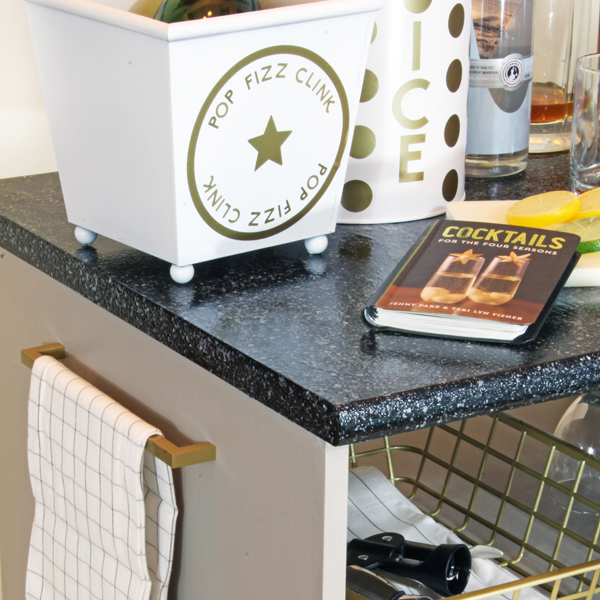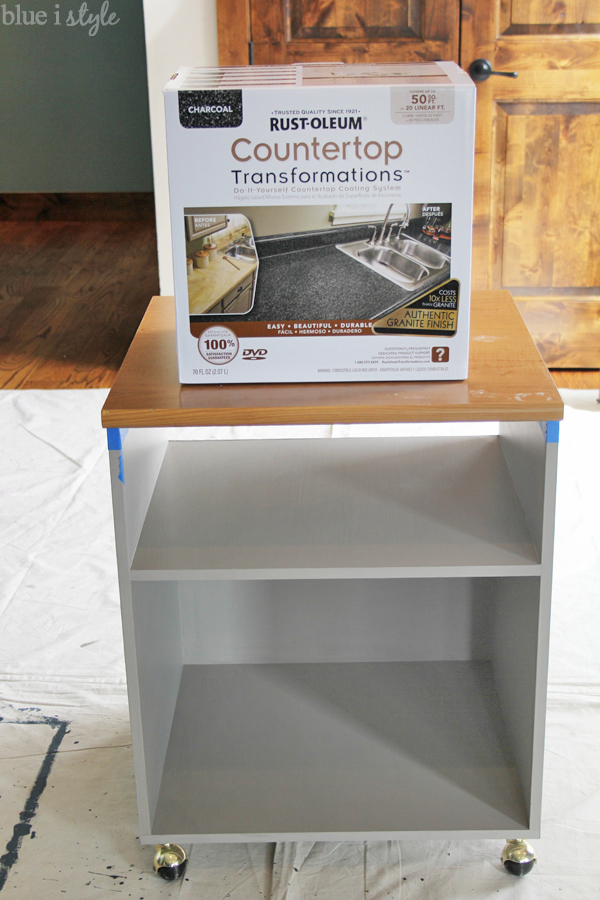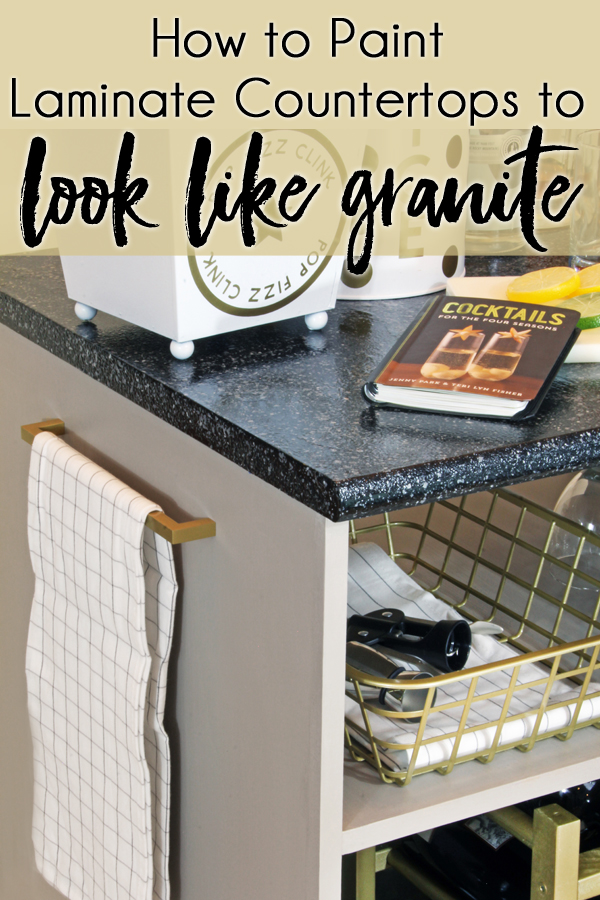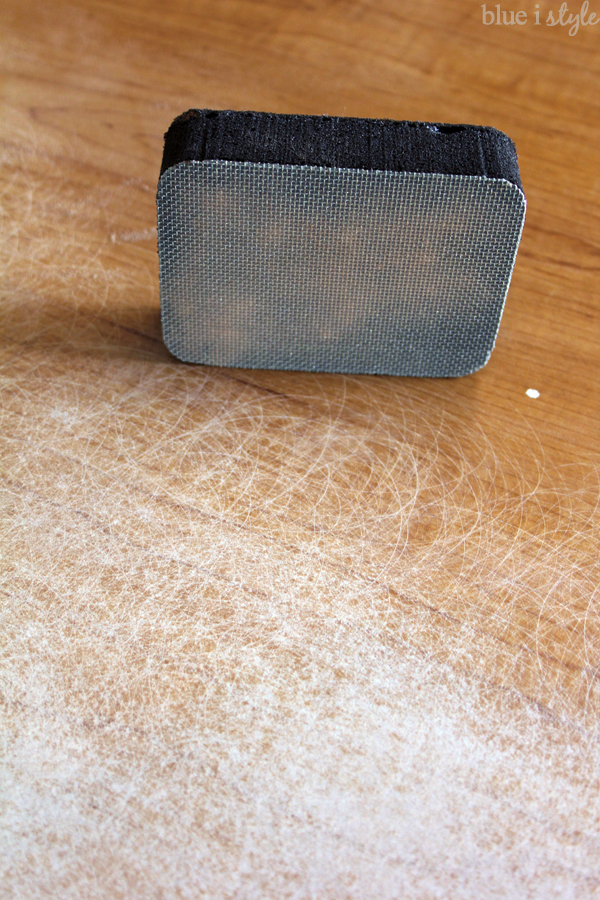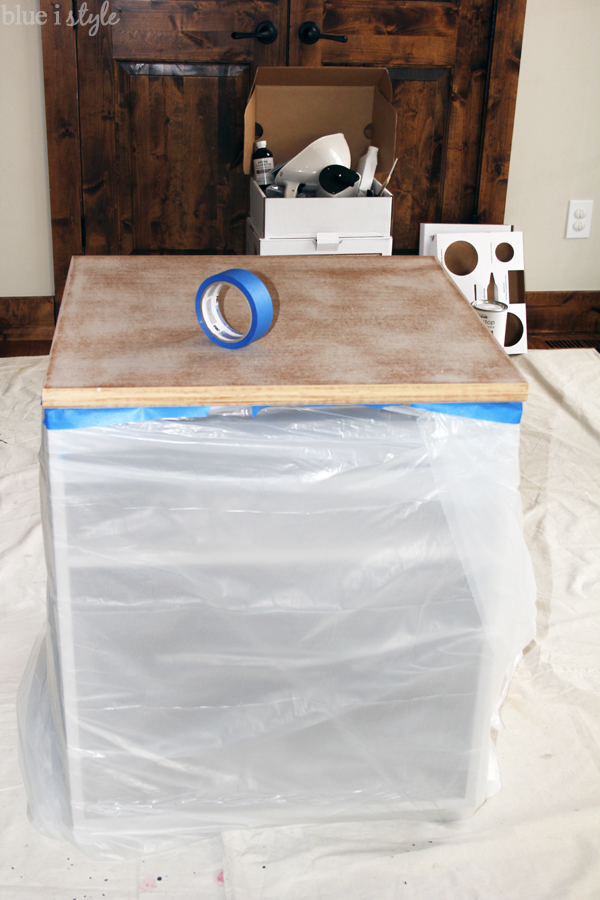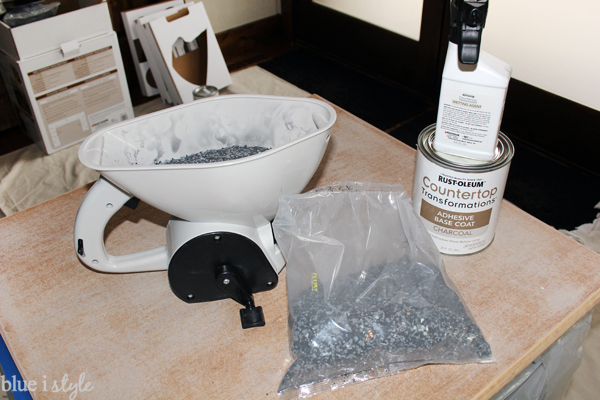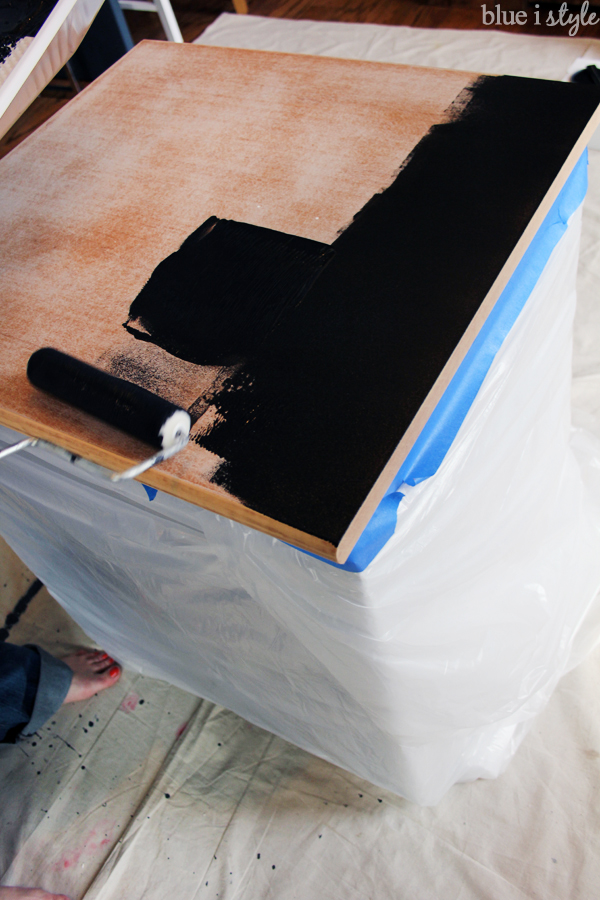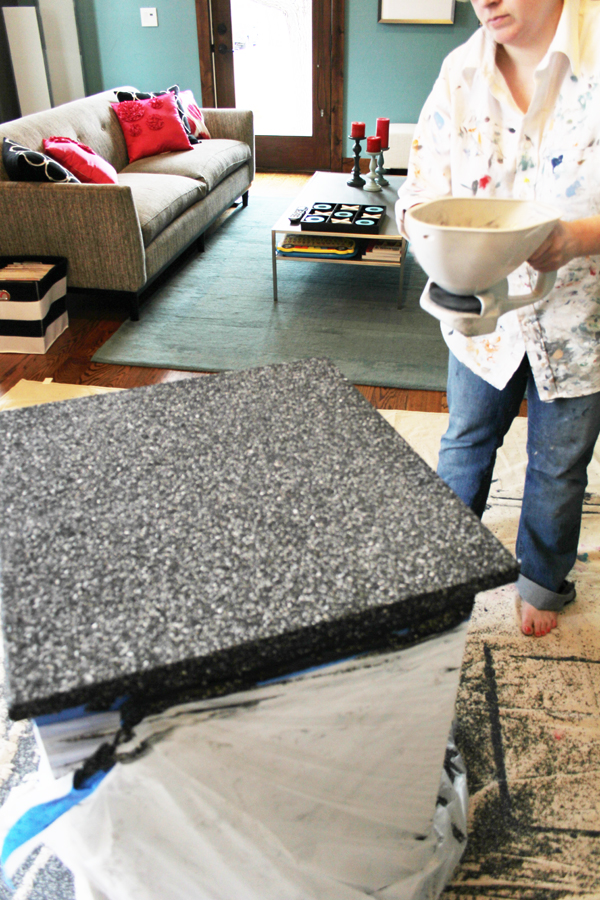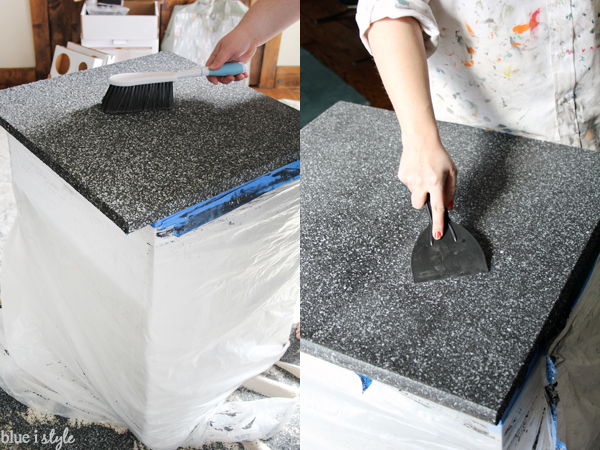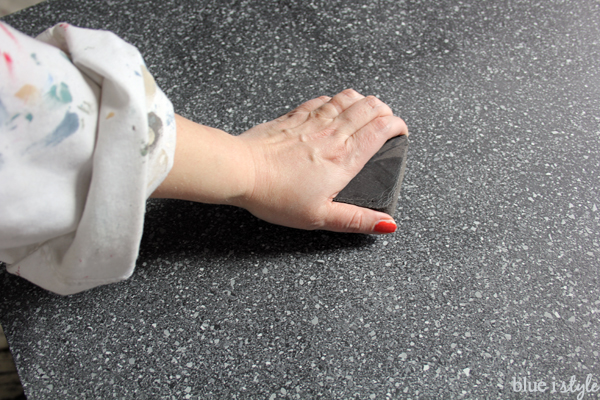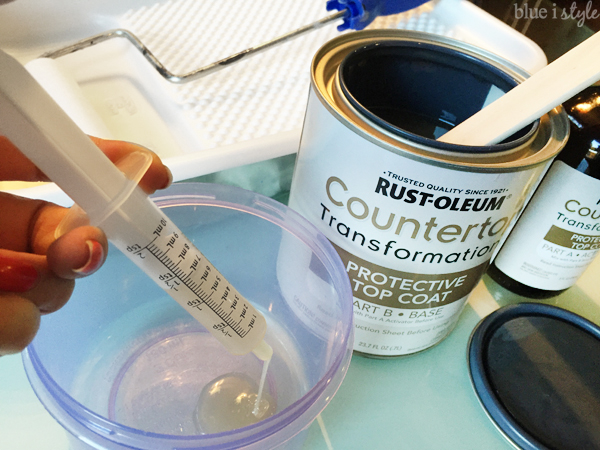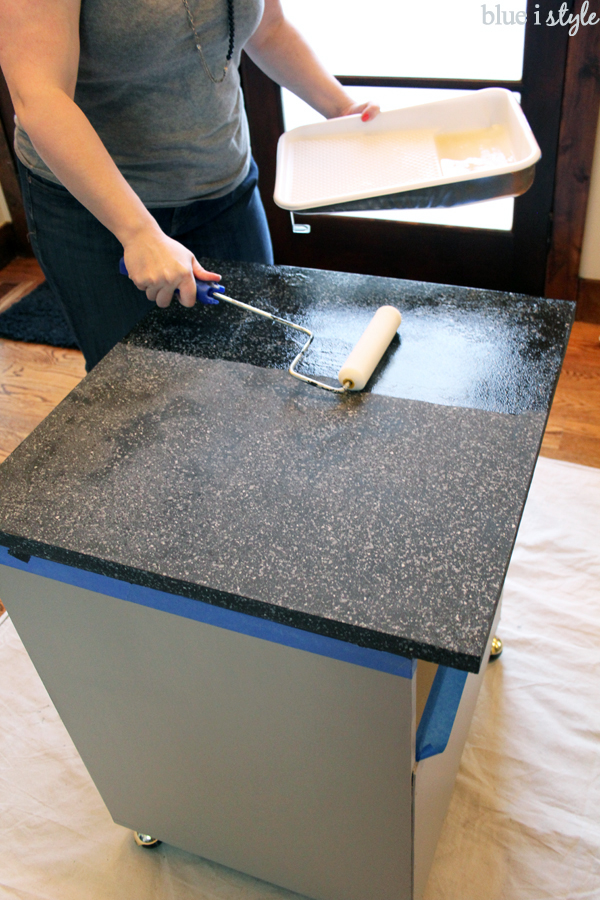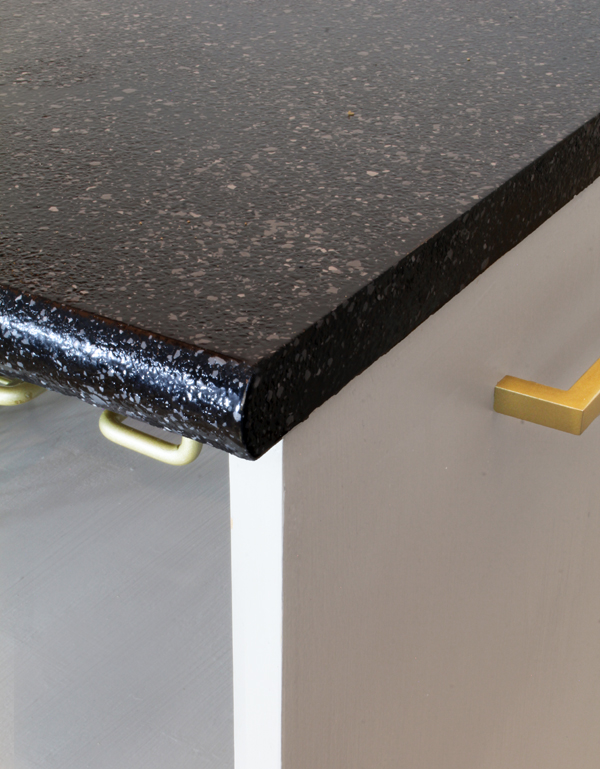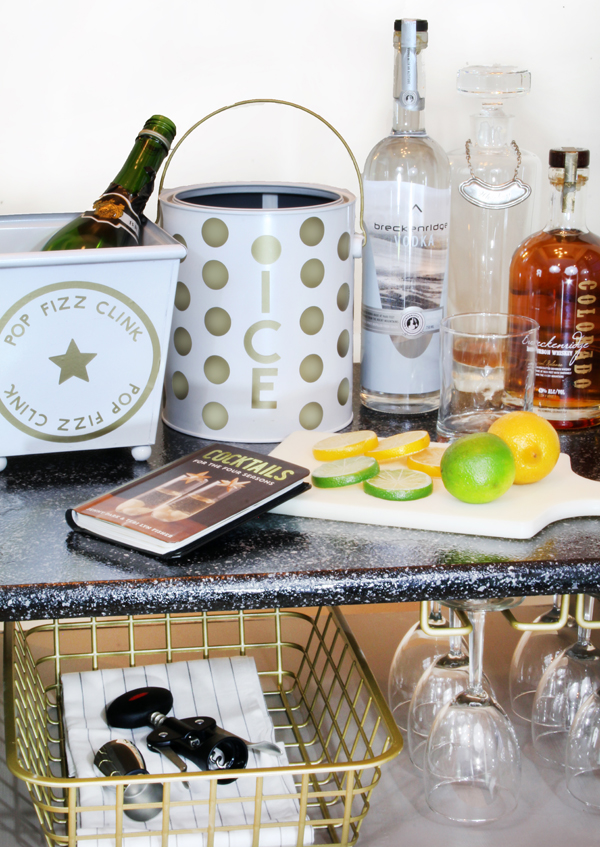I have received a few questions from readers lately asking for DIY kitchen update ideas that provide a high end look without a renovation budget. Painting kitchen cabinets is always a good option (and I’ve got a tutorial to help you get a professional, even finish), but another of my favorite tips is to update kitchen counters on a budget with paint to create the look of high end stone.
A while back I wrote a post about how to use a Rust-Oleum Countertop Transformations Kit to DIY granite look countertops, but my tutorial was buried in the middle of a post about my upcycled bar cart, where you would probably never find it. The recent reader questions about kitchen updates made me realize that it was finally time to create a separate post about how to paint laminate countertops to look like granite.
This post contains affiliate links. If you purchase something I recommend, I may receive a small commission, but you’ll pay the same price.
I’d seen the Rustoleum Countertop Transformations Kit at my local hardware store, and I was super curious to try painting laminate countertops. It’s a multi-step process that creates the look of real granite, which sounded like a DIY dream come true! But I don’t have any laminate counters in my house, and I was hesitant to offer to try kitchen countertop paint in a friends house until I knew what kind of results I would get.
When I was asked to do some furniture makeovers for a display at the Denver Home Show, I realized it was a perfect opportunity to try some of the DIY products I’d had my eye on, including the Rustoleum countertop paint and dry erase paint.
At my local Habitat ReStore I found a laminate printer stand and decided to turn it into a rolling bar cart, complete with a granite-look countertop. I consulted with my friends at Rust-Oleum, and they confirmed that this laminate furniture surface would accept the paint just like a laminate kitchen counter. It was the perfect test case!
HOW MANY COUNTERTOP TRANSFORMATION KITS DO I NEED?
A large Rust-Oleum Countertop Transformations Kit is enough to cover 50 square feet, and a small kit covers up to 30 square feet. Since the top of my tiny bar cart was only a whopping 4 square feet, I didn’t come close to using the full kit. That being the case, I obviously can’t say that this is the most affordable solution for such a tiny countertop, but Rust-Oleum was kind enough to send me a kit to test it out.
While I wouldn’t recommend you buy the kit just for a small project like mine, it is a fantastic option to give an outdated kitchen or bathroom a brand new look! And then any leftovers are perfect for dressing up the laminate top of a bar cart, a portable kitchen island, or even a inexpensive laminate dresser.
The large Countertop Transformations Kit currently comes in four color options: charcoal {this is the one I used, and it’s black with gray and white flecks}, java stone (brown), dessert sand (tan with a few dark flecks), and onyx (black with dark gray flecks). The smaller kit currently only comes in charcoal and dessert sand. I haven’t seen all of the colors on finishes surfaces, but I can say that the charcoal, in person, looks very similar to the dark granite counters I had in my previous home.
I received my Countertop Transformations Kit for free, but was not paid for this post. All opinions are my own and based on my personal experience.
HOW TO USE A RUST-OLEUM COUNTERTOP TRANSFORMATIONS KIT
The Countertop Transformations Kit comes with lots of supplies, and it is a very specific, multi-step process. It comes with an instruction guide, as well as a short DVD tutorial.
It’s not difficult at all – but it’s very important to follow all of the instructions carefully! Below I share a step by step overview of the process to help you understand what is involved and to show you my results, but be sure to also read and follow all of the instructions from Rust-Oleum.
STEP 1: Repair and Clean
STEP 2: Rough Up the Surface
Start by roughing up the laminate surface using the diamond embedded sanding block that comes with the kit. Use both hands to press down on the sanding block, and sand in a fast, circular motion. Don’t forget to sand the front and side edges of the countertop as well.
This process creates a lot of very fine dust, so wearing protective eyewear and a dust mask is a good safety precaution.
STEP 3: Prep for Painting
Before moving on to the painting step, use painters tape to tape of any areas that won’t be painted. In a kitchen or bathroom, this would include around the edges of the sink and along the walls. Make sure to also cover up any drains to keep out the decorative chips that you’ll apply in step 6.
Use a plastic drop cloth and painter’s tape to cover the cabinet(s) below the countertop, and also cover any adjacent walls or backsplash tile. Layout a drop cloth on the floor below the counter as well.
STEP 4: Prepare the Decorative Paint Chips
STEP 5: Paint Adhesive Base Coat
Stir to mix the adhesive base coat, then pour some into a paint tray. Working in small, manageable sections, use a synthetic paint brush to paint the edges and backsplash of the counter, and use a dense foam roller to coat the larger surface areas of the countertop with the black adhesive base coat. Apply a thick, smooth coat, ensuring that none of the laminate surface shows through..
STEP 6: Spread the Decorative Color Chips
Spray the wetting agent over the adhesive painted surface to help keep the base coat wet and tacky longer. Get a nice, even coverage of the wetting agent, without making the surface too wet or creating any pools or puddles.
Working quickly, while the adhesive base coat remains wet, use the dispenser tool to spread the decorative color chips, heavily coating the entire counter surface.
The dispenser tool works like a fertilizer spreader – you just pull the trigger on the inside of the handle and turn the crank clockwise to make the decorative color chips shoot out of the front. This is definitely the most fun {and messiest} part of the process, but covering the floor in a large drop cloth makes cleanup much easier.
Start by applying the decorative chips to the backsplash and front edge of the countertop, and then to the flat surface area. More is more when it comes to applying the chips, so apply a thick coating and ensure that none of the adhesive base coat remains visible.
If the chips don’t stick to an area, simply use a sponge to dab on more adhesive base coat in that spot, and then immediately cover the spot with the decorative color chips.
STEP 7: Remove Excess Chips and Smooth
Let the countertop dry for at least 12, but not more than 24 hours, then use a shop vac with a brush attachment or a small hand broom to brush away all the loose, excess decorative chips.
STEP 8: Sand Until Smooth
Using the diamond embedded sanding block that came with the kit, sand the counter until it is extremely smooth, but be careful not too sand through all the chips. If you do wind up with any bare spots or gouges in the surface, again use a sponge to dab on more adhesive base coat in that spot, and then immediately cover the spot with the decorative color chips, allow it to dry and then repeat steps 7 and 8.
STEP 9: Apply the Protective Top Coat
Once the counter is totally smooth, you’re ready to apply the protective top coat, which is a two part formula. The instructions call for mixing all of the activator {part A} into the base {part B}. However, once mixed, the protective top coat must be used within 4 hours.
Since I had only used a small portion of the total Countertop Transformations Kit, I wanted to save the rest for another project in the future. That meant I couldn’t mix the entire protective coat all at once. Instead I calculated the ratio of Part A to Part B, and used a syringe to measure and mix just enough for sealing my small bar cart countertop.
Once the protective top coat is mixed, use a synthetic paint brush to paint the edges and backsplash of the counter, and use a dense foam roller to coat the larger surface areas of the countertop. Apply a thick, smooth coat. Once the entire counter is covered, lightly reroll the entire counter in one direction to ensure a smooth, even finish.
Allow to Dry Before Resuming Use
Be sure to keep the counters free from dust and dirt while the top coat is drying. Keep the widows in the room closed and ceiling fans off. Allow the top coat to dry for 4-6 hours (dry times will vary depending on your climate), then gently remove the painters tape, scoring along the edges before peeling the tape away to ensure that it doesn’t peel away any of the painted surface.
Then let the countertop dry for about 48 hours before resuming light use, such as sitting items on the counter that weigh less than 5 pounds. Allow the counters to dry for a full week before resuming regular use. Apply silicone caulk around the edges of the sink for a waterproof seal.
How to Clean Painted Countertops
Once your Countertop Transformations painted countertops have fully cured, you can clean them with a soft cloth and soapy water or gentle, non-abrasive cleaners. Avoid staining by cleaning up spills promptly, and use cutting boards and trivets to avoid scratching and the surface, just like you would with real stone.
Rust-Oleum also has an instructional video that you can watch online here.
